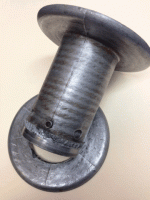Nobody said the comp winch overheated. Some winches dissipate heat differently. The op said that in the original post. He also said when too much heat is dissipated through the drum this is when you run into problems with synth line. I think the evotj story illustrates this just as he was describing. Anyway I think as many others stated the benefits out way the negatives. I think he was just trying to make people aware of it.
Sent from my XT907 using WAYALIFE mobile app
yea i didnt mean to say overheated it was just the first thing that came to my mind while tryong to work and read lol i was saying to David that they were having issues with evotj because of how many fast hard pulls they did causing the line to fail. the drum heat in those pulls was to much for it.
Look at Greg's post from KOH. He said there line kept snapping from the heat of hard pulls. I think this is what the op is talking about
Sent from my XT907 using WAYALIFE mobile app
You are exactly correct by assuming that. Prior to us snapping the synthetic line repeatedly (4 times) on Chocolate Thunder, we were doing some really hard pulls, lots of them, up Aftershock. Many of those pulls were when we had only three tires (rear passenger tire was nonexistent, we only had a beadlock) and were winching up waterfalls. The synthetic line had taken far too much heat and abrasive abuse up and over rocks, but these were all extreme race conditions while on the clock. I would hope that in the average weekend scenario on the trail, guys would take far more precaution than we do during a race. We are professionals, safety is #2 (maybe 3) on our list of concerns

That last statement is not to be taken seriously, however safety is probably #2.
For all those following this thread, I still stand by synthetic winch rope versus steel. Not certain if there will be video of it when the winch line snapped the first time on Chocolate Thunder, but it actually hits my leg. And just like synthetic rope is supposed to do, it did not store kinetic energy, and pretty much just dropped to the ground after it hit my leg with the force of a pillow. Although the gasps from the crowd were pretty cool when it happened!
Also, another concern besides just heat is the drum construction itself. This image is from an aluminum drum that was upgraded from steel to synthetic. The cast aluminum drum couldn't handle the ropes push on the drum flange and BOOM -the rope won. So here's whats going on: the slippery rope won't stack on itself very well, instead it wants to dig down between layers. That digging down puts a load on the drum flanges and when it gets too high a load - pop! Off comes the flange.
If the drum was aluminum, that is probably not a quality winch :thinking: I would argue the point that steel would have done the same thing to the drum. The only time a winch line stacks neatly side to side and on top of each wrap is when you are re-winding and guiding line by hand in a driveway after a day on the trail. In all my years of winching I have never seen steel or synthetic wrap neatly on it's own during a recovery, because there is no time to be concerned with neat wraps, its about the recovery at that point. Steel sucks down between wraps just as easily as synthetic. Also, once that steel line kinks or flat spots, you will always have trouble trying to neatly wrap it back on the spool. In fact I will just say from personal experience that it is virtually impossible to re-wrap a steel cable neatly onto a spool after the cable has been bent, kinked, flat spotted without risk of having a hole in the wraps that will suck the line into and pinch it so tight that you will have to use the weight of the vehicle to pull it back out and off the spool.
For me, steel winch rope still had just so many negative qualities working against it for use on the trail.

